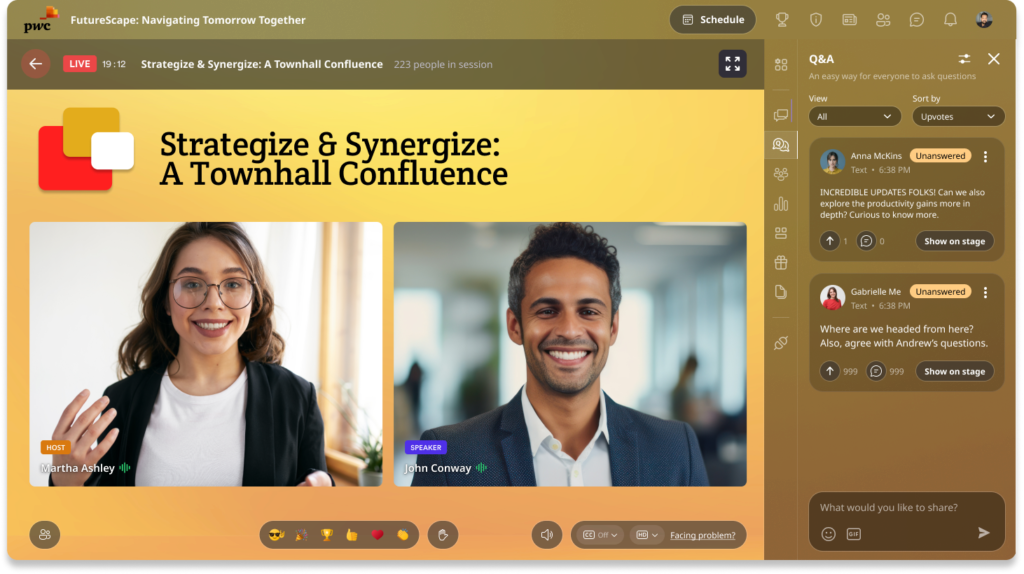But traditional, in-person events are notorious for how resource-heavy they can get, especially with budgets! Fast forward to today, we know that virtual events and webinars play a huge role in any organization’s success, allowing businesses of all sizes to reach new customers, create thought leadership and grow their reach.
While virtual events may have become a top-priority for marketing teams, the world over, it pays to understand the exact reasons for such a rapid transformation in the events industry. In what ways do virtual events stand out as the superior alternative to traditional, in-person events. How exactly can organizations benefit from investing in virtual events?
Here are some of the most important reasons why global organizations have been switching to virtual events.
Why are Organizations Switching to Virtual Events?
- Global reach: Virtual events open up the opportunity for businesses to target and attract participants from all over the world. This allows you to reach a much wider audience base and market your business on a global level. A traditional in-person event does not provide this luxury, as it requires attendees to be physically present at the specific venue.
- Sustainability: Virtual events have a minimal environmental impact, when compared to traditional in-person gatherings. You get to eliminate the need for people to travel, save on electricity, reduce paper consumption, etc – all of which help to reduce carbon emissions.
- Cost-effectiveness: Virtual events are definitely less expensive to host than traditional in-person gatherings. Organizers do not have to invest a bomb on venue rentals, catering, transportation, safety protocols, and so many other expenses that come with hosting traditional events.
- Audience Insights: Virtual events enable companies to gather real-time audience interaction data and feedback from attendees, which can subsequently be used to tweak the ongoing event and also inform your future event marketing strategies and product development.
- Data-driven insights:- Virtual events offer a wealth of information that may be used to improve your marketing strategy. Attendee engagement, session popularity, booth visitor data, and a lot of other nuanced metrics that may be tracked, measured, and improved for virtual events.
- Flexibility: Because virtual events take place online, you have a variety of formats to explore. To participate in or host a virtual event, you only need an Internet connection and a device that can connect to the Internet. Most systems are compatible with desktop computers, laptops, smartphones, and tablets.
- Increases engagement: Virtual events might be more interactive than in-person ones. This is because they include a range of participatory elements like as polls, surveys, Q&A sessions, lounges and breakout areas.
How to create a successful virtual event?
Here are some best practices to help you put together a virtual event that delivers value to the organizers as well as attendees.
Step 1- Define your audience
Before you design your virtual event, you need to know your target audience. This will help you in determining the type of event you want to host. Now define the objectives or results you hope to achieve from the event, based on your target audience. It also helps you to decide when and where to hold the event, and what should be convenient for your attendees.
Define your target audience by considering their age, occupation, their interests and goals, andsuch details. This allows you to organize an event that is beneficial to them. Consider what problems your audience may be facing, so you can curate an event that can help them find possible resolutions.
Step 2- Choose a virtual event type and format
There are several types of virtual events to choose from, including networking gatherings, industry expos, fundraisers, and conferences. Once you’ve defined your audience and goals, you should be able to determine the type of event you want to hold.
The second factor to consider is the format of your virtual event. You can pick between live streaming, pre-recorded events, or a combination of the two. A live stream event is one that you broadcast and your audience joins in real time. You can also record a live broadcast event for other attendees to view later.
Step 3- Plan the content
Now that you know the specifics of your virtual event, spend time curating high-impact content. Make a plan outlining the themes you intend to cover, the sessions you want to include, and the presenters. Assign time slots to each topic or session so you can approximate the duration of the entire event and make adjustments as needed.
Step 4 – Consider the logistics
Next, plan the logistics for your event. This includes details such as when the event will take place, who will be invited, and how you plan to host it. Because it’s a virtual event, the most critical factor to consider is the technology you’ll employ. At this point, examine the following questions to assist you to figure out the logistics of your event:
- Which platform will you use to host the event? If you already have an existing virtual event platform, does it serve you well or do you need to replace it with a better platform?
- How many attendees are expected?
- Can that virtual event platform serve the number of attendees expected?
- Does that platform support the event format, such as allowing guest speakers to become hosts or setting up separate rooms for smaller discussions?
- How will you deliver invitations and track your responses?
- How will you handle payments or donations from attendees?
- Who are the speakers at your event, and do they have the necessary equipment or technology to participate?
- What to do in case of tech difficulties or glitches?
Answering these questions can help you organize the ideal event. It enables you to tackle problems before they occur and be prepared for the day.
Step 5 – Send out virtual invites or promote the event
Create a personalized email campaign and send out invitations to your target audience after you’ve completed all of your planning. Consider using event management software to send out invitations and collect response more efficiently. Collecting responses allows you to determine the amount of people who will attend your event and plan accordingly. Organize all the participant contact information so that you can track accordingly.
How to Create a Virtual Event on Airmeet?
Step 1: Go to the homepage or host login page of Airmeet. Sign in with your official credentials. Once you login to your account, click on the “Create Event” button.
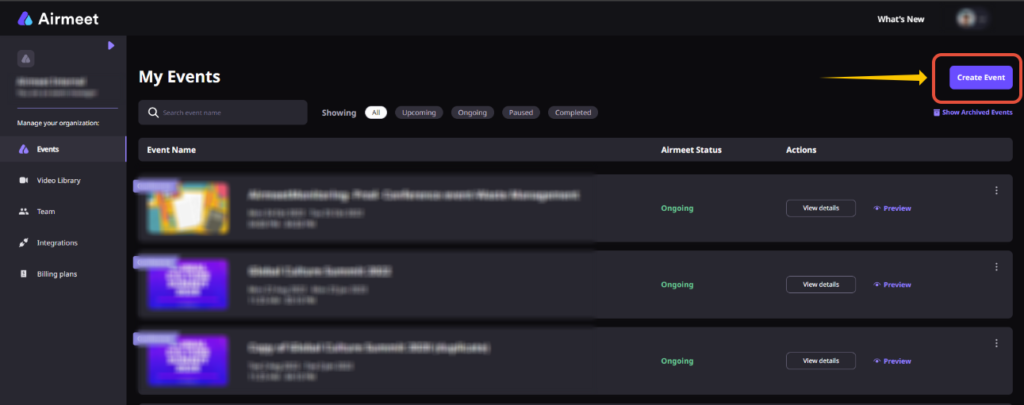
Step 2: Select any event format being shown in the dashboard or create your own new event format and then click on “Proceed”.
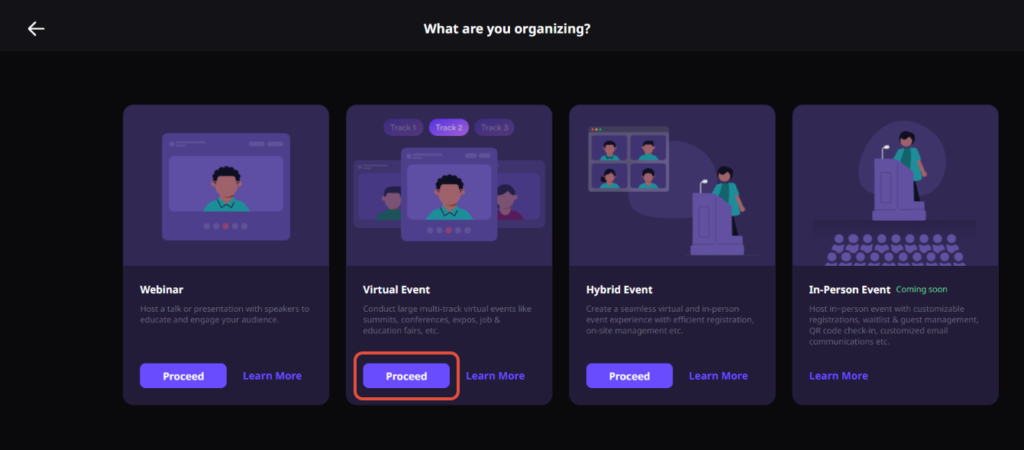
Step 3: Select the type of “Virtual Event” template which perfectly goes with the event you are planning for or you can also create from scratch by clicking on “Create from scratch“.
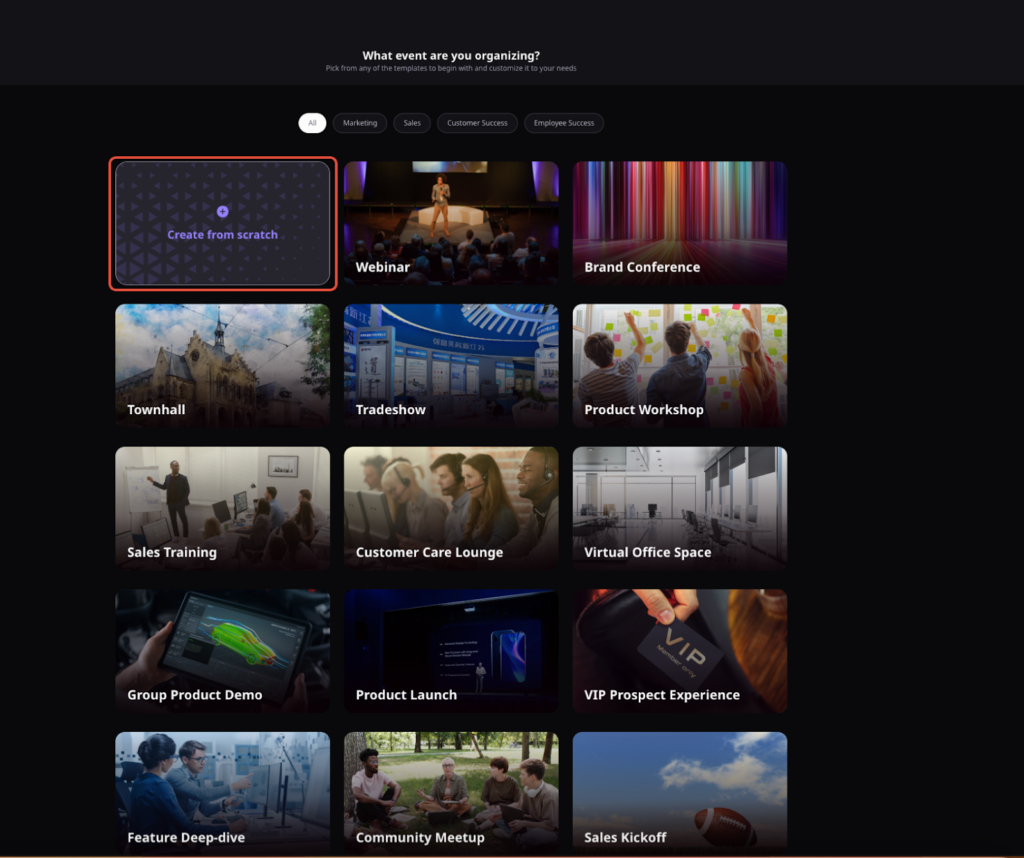
Step 4: Enter the following event details:
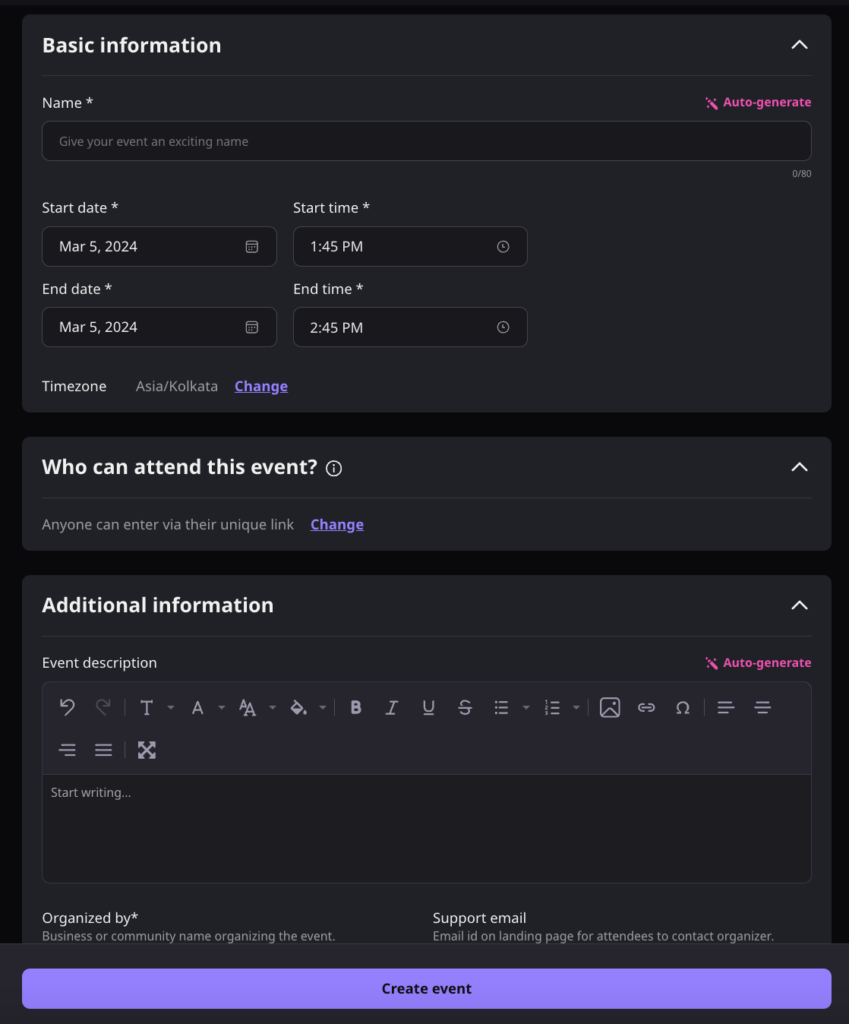
Event Name: Enter the name of the event that is planned to showcase on the landing page.
Start & End Date and Time: Enter the event start and end dates and times that need to be showcased on the landing page for the general audience.
Timezone: Update the time zone as per the event if needed by clicking on “Change.”
Event Entry Type: Select from the given options on how you’d like your attendees to join the event.
Event description: Prepare an overview of the event for your attendees to read. You can also change the text backdrop and font color, as well as include hyperlinks and photos.
Organization Name: Enter the name of business or community organization that will be hosting the event. This information will be displayed on the event landing page.
Support email: Enter the organizer’s or support team’s email address. This enables attendees to reach out to organizer if they have any questions.
Step 5: Click on “Create Event”. Now, your Airmeet has been successfully created.
To change any of these details later, Go to “Event details” on the right-hand side of your event dashboard and click on the “Edit” button”.
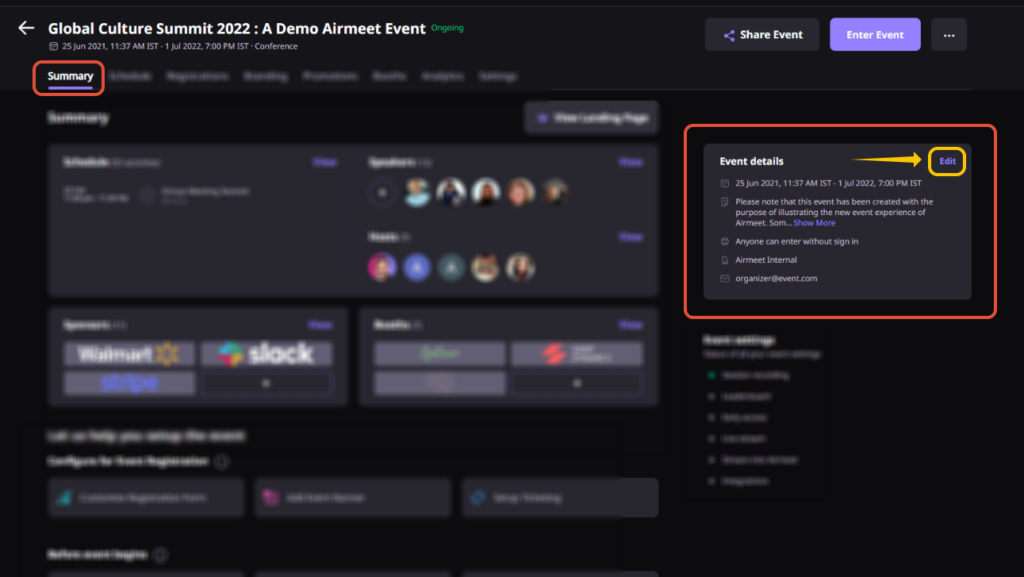
Step 6: You will now enter the “Event Dashboard,” where you can set up your whole event.
How is a hybrid event platform different from a virtual event platform?
A virtual event is a live event hosted fully online. A hybrid event is a live online event with a physical component. Both types of events can incorporate remote presenters, and in both, the participants attend by logging in from their home or office computers.
But there are key differences between the two:
- In a virtual event, all presentations are delivered online via web conferencing software. Whereas, In a hybrid event, some presentations are delivered online via web conferencing software, while others are offered on-site.
- Virtual audiences can be larger than traditional room-based audiences since they are not constrained by available seating. Whereas, hybrid events allow participants to engage in person while also taking advantage of the convenience of an online platform for keynotes, breakout sessions, and other conference-related materials. Hybrid events also provide possibilities to participants who would otherwise not be able to travel, owing to geographic limitations or budget constraints.
How do Artificial Intelligence (AI) and Virtual Reality (VR) Influence the Transformation of Virtual Event Platforms?
Artificial Intelligence (AI) and Virtual Reality (VR) are both making important contributions to the transformation of virtual event platforms, improving user experiences, interaction, and overall engagement. Here are some ways in which these two technologies contribute to the future of the events industry:
- AI-powered personalization: AI systems can tap into user data and behavior to provide tailored experiences. AI can recommend programs, booths, and networking opportunities based on guests’ preferences, making their experience more relevant and engaging.
- Enhanced Networking: AI can help attendees find better matches based on their profiles, hobbies, and goals. Virtual event platforms can use AI algorithms to recommend relevant contacts, arrange meetings, and even facilitate group conversations depending on attendee preferences.
- Virtual avatars and chatbots: VR technologies allow for the creation of life-like avatars that attendees can use to explore virtual surroundings. These avatars can engage with one another, simulating real-world networking experiences. AI-powered chatbots can help attendees navigate, provide session or exhibitor information, and respond to frequently asked questions in real time.
- Immersive Experiences with VR: VR technology allows users to engage with 3D content, watch seminars, and explore virtual booths. This fosters a sense of physical presence and participation that extends beyond standard video conferencing platforms, making virtual events more memorable and meaningful.
- Real-time Interactivity: AI-powered capabilities like real-time language translation, sentiment analysis, and live polls can improve engagement at virtual events. Attendees can participate in discussions despite language hurdles and offer their feedback via surveys. Organizers, on the other hand, can evaluate audience sentiment to tailor their presentations or discussions accordingly.
- Data Analytics and Insights: AI-powered analytics solutions can provide useful information about attendee behavior, preferences, and engagement patterns during virtual events. Organizers can use this data to determine what content resonates with their target audience, find areas for improvement, and optimize future events for greater results.
- Content Curation and Recommendation: AI algorithms can scan large amounts of content, such as presentations, films, and papers, to select relevant and high-quality materials for participants. Understanding the needs and preferences of your attendees allows AI to offer courses, workshops, or resources that fit with their interests, ensuring they get the most out of the virtual event experience.
The future of Virtual Corporate Events
Virtual events are said to generate $774 billion by 2030, suggesting a massive increase in its adoption, promoting economic growth and creating possibilities for organizations across the world.
The global virtual events market size in 2020 was valued at around $94.04 billion.
It is further estimated that this market will grow at a rate of 23.7% from 2021 to 2028.
FAQ
Airmeet is a comprehensive platform that enables virtual, hybrid, and in-person events. Airmeet provides tools and features you’ll need to ensure a seamless experience. The platform’s various capabilities allow organizers to adapt to a number of event formats while providing attendees with immersive and interactive experiences in any setting.
Yes, many virtual event platforms include analytics and reporting options for gathering event attendance and interaction data. This data can provide useful insights into attendee behavior, engagement, and preferences, allowing you to better understand your audience and plan future events.
Yes, online event systems like Airmeet frequently include social media integration options, allowing event organizers to use social media to promote their events, communicate with attendees, and broaden the event’s reach. Airmeet integrates seamlessly with key social networking platforms like LinkedIn, Facebook, and Twitter.
Airmeet, Zoom, vFairs, ON24, Hopin, and GoToWebinar are among the virtual event platforms that support event apps to enhance event accessibility and user experience.



